
 |
Fourth-Bid Transfers |
The commonly employed combination of New-Minor Forcing
and Fourth-Suit Forcing is flawed. After a
1♣ opening bid, using 2♦ as
New Minor wastes bidding space and limits both bidders' options.
Opting for Checkback Club is better, but it is not enough.
Fourth-Suit Forcing — a catch-all for situations
where no other forcing bid is available — also is inadequate.
More recently, the XYZ convention gained popularity — and rightly
so, because it resolves certain defects in the older methods. It falls short
in other ways, however; you can do better.
The use of transfer rebids by responder provides so much flexibility that one might have some difficulty in deciding what to do with all the available choices! Many designs are possible. The suggested matrix conforms to our standard philosophy which ascribes great importance to the identification of singletons, and it integrates well with our other methods.
Advantages:
- better control of most auctions
- saves bidding space with good hands
- pinpoint responder's distribution in many sequences
- choose who declares in notrump games/slams
Disadvantages:
- cannot play in two clubs after a
1♣opener. (you can live with it)
This method makes no accommodation for hands where responder has opener's minor
and no major. Inverted Minors serve that purpose. Also, we use
1♣-2♦ as showing a six-card suit,
8-10 points; therefore, some of our actual structure varies from the chart
after 1♣-1♦-1x.
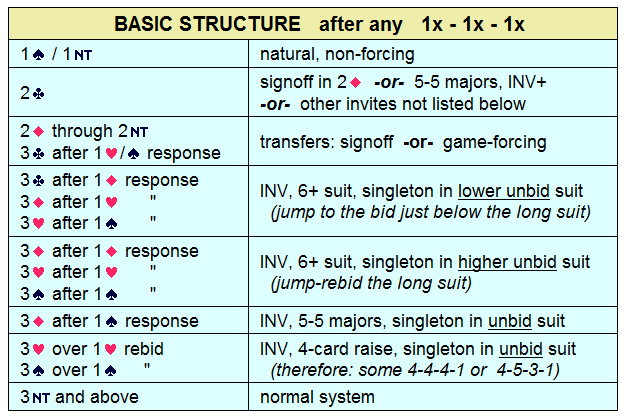
Details
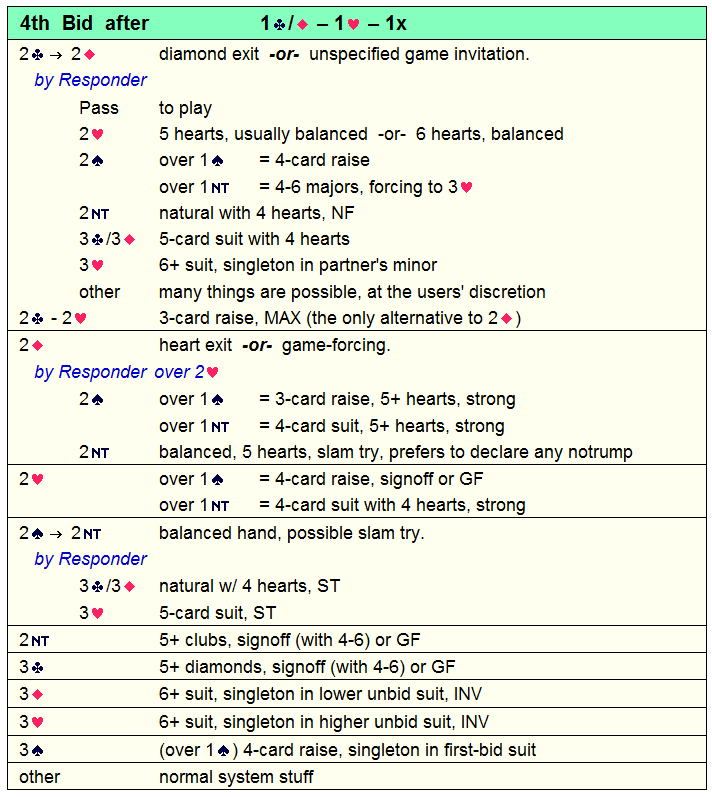
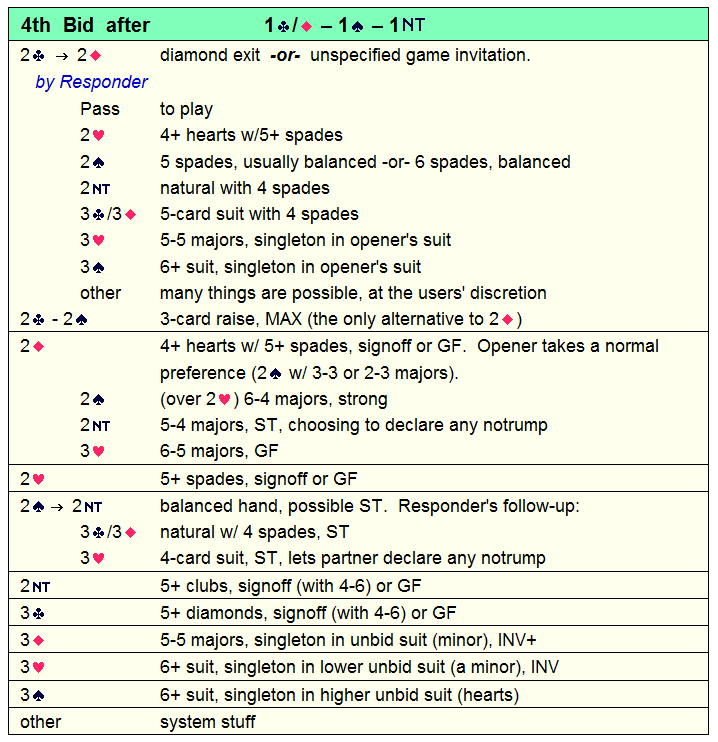
The follow-ups to 1♥-1♠-1NT
are unique, in that responder can specifically raise opener's suit at the two-level
before proceeding. This results in a case of having more calls available than one
can realistically utilize. This chart offers some suggested continuations not
previously covered. You get to fill in the blanks (or, if you feel
adventurous, try our industrial-strength Major Suit Raises).
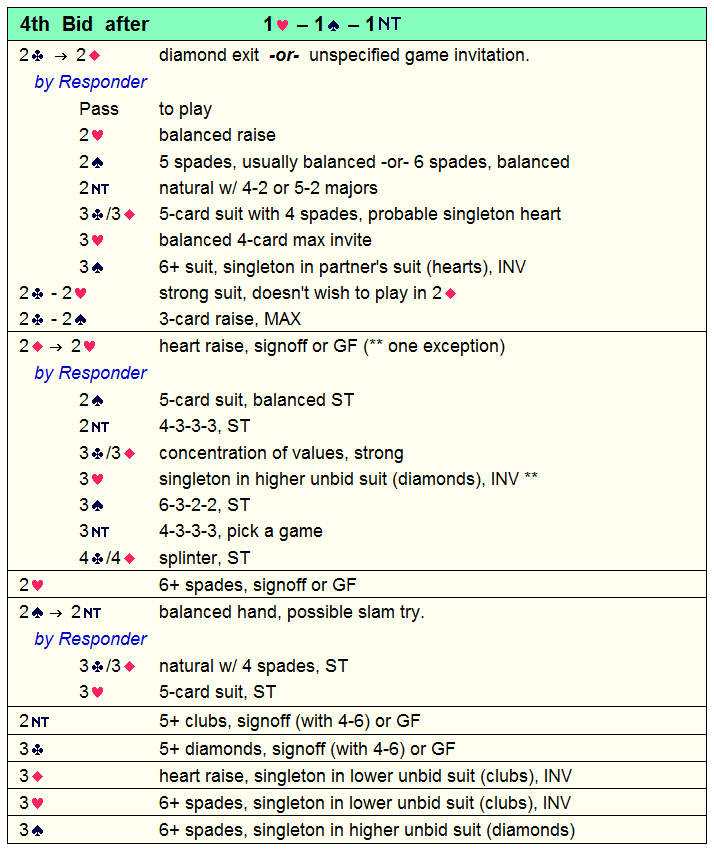
** In order to retain all of responder's singleton-showing patterns with
long spades, this otherwise unneeded call enables responder to specify
singletons in support of hearts as well, with invitational hands. This
sequence is the only one that digresses from the normal 'signoff or
game-force' guideline.
General Guidelines
System is on over any interference, as long as the
2♣ invite is available to responder — even
if you and partner have not actually made three bids. Most commonly, an auction
would include a single takeout double or overcall by a single opponent.
More complicated situations could arise, however:
With ordinary hands opener always accepts a 'transfer', unless he is too strong to have partner pass, with two exceptions:
If opener has enough stuff to raise a potential signoff, he makes a forward-going
bid — anything other than 2♠.
Example: 1♣-1♥-1♠-2♥
(spade raise). Opener has a choice of game tries:
2NT, 3♣, a red-suit cuebid, or
3♠.
Responder's second call has priority over subsequent bids:
Direct raises are 4+ fits; delayed raises are 3+ support. Example:
1♦-1♠-1NT
A rebid of the first suit, followed by a new suit suggests six of the first suit.
Example: 1♦-1♥-1♠.
Responder has choices with balanced hands. Example:
1♣-1♥-1♠
4th-Bid Transfers — Minimal Structure
This minimal version is easy to implement and easy to remember. Even in its simplest form, the 4th-Bid Transfer is more robust and flexible than other published methods.
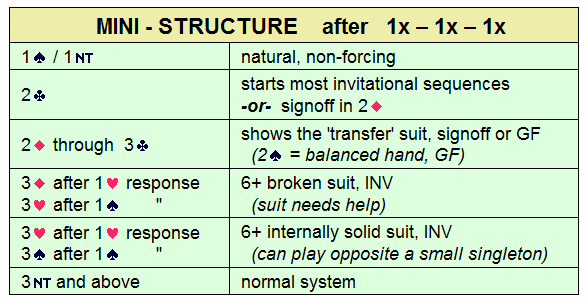
Notes / Memory Aids
Transfers apply up to 1 bid below the 3-level of the highest-ranking bid suit
bid by your side. (example: 3♥ if spades have been bid)
With ordinary hands opener always accepts a 'transfer' unless he is too strong to have partner pass, with two exceptions:
All game tries begin with 2♣ (unpassed hand),
excepting the 3-level jump rebids with a long suit.
Conversely, 2♣ always is a game try, excepting a possible
signoff in 2♦.
Direct raises by responder tend to be 4+ support; delayed raises tend to be
3-card support.
System is on irrespective of interference or number of bids made, as long as
the 2♣ function is available.